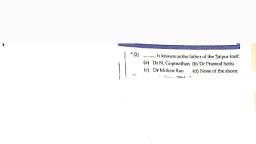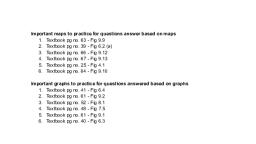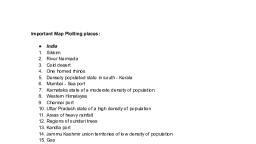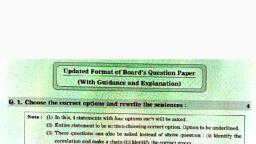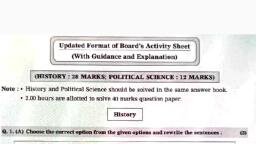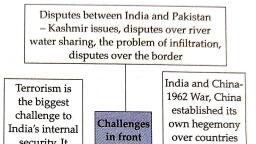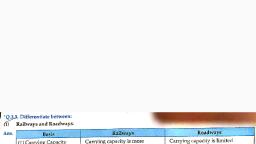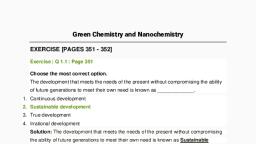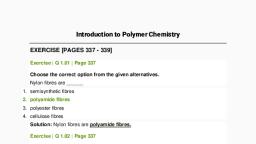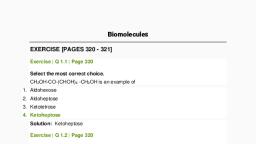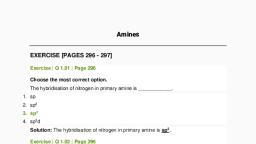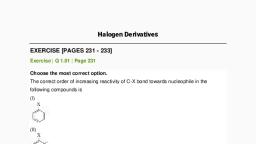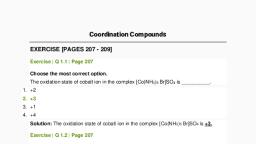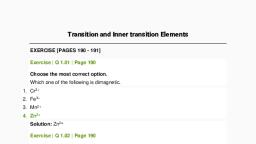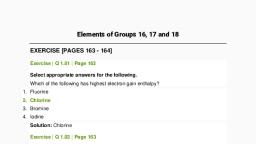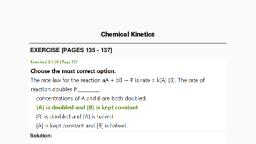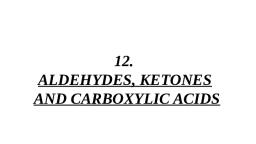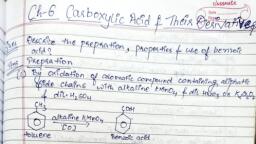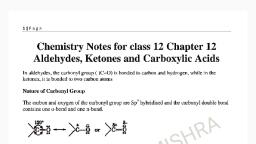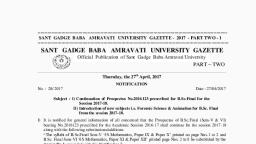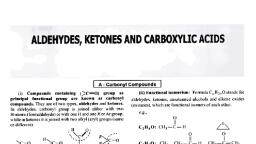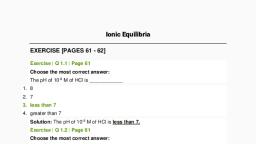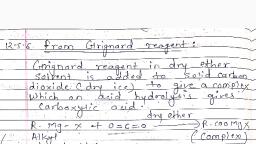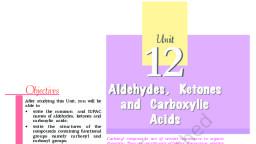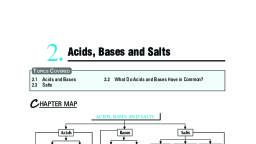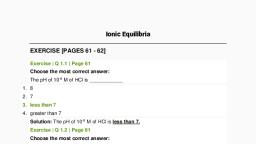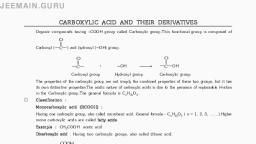Page 1 :
Aldehydes, Ketones and Carboxylic acids, EXERCISE [PAGES 280 - 281], Exercise | Q 1.1 | Page 280, Choose the most correct option., In the following resonating structures A and B, the number of unshared electrons in, valence shell present on oxygen respectively are, , 1. 2, 4, 2. 2, 6, 3. 4, 6, 4. 6, 4, Solution: 4, 6, Exercise | Q 1.2 | Page 280, Choose the most correct option., In the Wolff-Kishner reduction, alkyl aryl ketones are reduced to alkyl benzenes. During, this change, ketones are first converted into, 1. acids, 2. alcohols, 3. hydrazones, 4. alkenes, Solution: hydrazones, Exercise | Q 1.3 | Page 280, Choose the most correct option., Aldol condensation is, 1. electrophilic substitution reaction, 2. nucleophilic substitution reaction, 3. elimination reaction, 4. addition - elimination reaction
Page 2 :
Solution: addition - elimination reaction, Exercise | Q 1.4 | Page 280, Choose the most correct option., Which one of the following has the lowest acidity?, , 1., , 2., , 3., , 4., Solution:, , Exercise | Q 1.5 | Page 280, Choose the most correct option., Diborane reduces, 1. ester group, 2. nitro group, 3. halo group, 4. acid group, Solution: acid group, Exercise | Q 1.6 | Page 280, Choose the most correct option., Benzaldehyde does NOT show positive test with
Page 3 :
1. Schiff reagent, 2. Tollens' reagent, 3. Sodium bisulphite solution, 4. Fehling solution, Solution: Fehling solution, Exercise | Q 2.01 | Page 280, Answer the following in one sentence., What are aromatic ketones?, Solution:, The compounds in which a, group is attached to either two aryl groups or one, aryl and one alkyl group are called aromatic ketones., e.g., , Exercise | Q 2.02 | Page 280, Answer the following in one sentence., Is phenyl acetic acid an aromatic carboxylic acid?, Solution: Yes, phenyl acetic acid is a side-chain aromatic carboxylic acid., Exercise | Q 2.03 | Page 280, Answer the following in one sentence., Write reaction showing conversion of ethanenitrile into ethanal., Solution:, , Exercise | Q 2.04 | Page 280, Answer the following in one sentence., Predict the product of the following reaction:
Page 4 :
Solution:, , Exercise | Q 2.05 | Page 280, Answer the following in one sentence., Name the product obtained by reacting toluene with carbon monoxide and hydrogen, chloride in presence of anhydrous aluminium chloride., Solution: The product obtained by reacting toluene with carbon monoxide and, hydrogen chloride in presence of anhydrous aluminium chloride is 4Methylbenzaldehyde., Exercise | Q 2.06 | Page 280, Answer the following in one sentence., Write reaction showing conversion of benzonitrile into benzoic acid., Solution:, , Exercise | Q 2.07 | Page 280, Answer the following in one sentence., Name the product obtained by the oxidation of 1,2,3,4-tetrahydronaphthalene with, acidified potassium permanganate., Solution:, The product obtained by the oxidation of 1,2,3,4-tetrahydronaphthalene with acidified, potassium permanganate is Phthalic acid or benzene-1,2-dicarboxylic acid., Exercise | Q 2.08 | Page 280, Answer the following in one sentence., What is formalin?, Solution: Aqueous solution of formaldehyde gas is called formalin., Exercise | Q 2.09 | Page 281, Answer the following in one sentence.
Page 5 :
Arrange the following compounds in the increasing order of their boiling points:, Formaldehyde, ethane, methyl alcohol., Solution: Ethane < Formaldehyde < Methyl alcohol, Exercise | Q 2.1 | Page 281, Answer the following in one sentence., Acetic acid is prepared from methyl magnesium bromide and dry ice in presence of dry, ether. Name the compound which serves not only as reagent but also as a cooling, agent in the reaction., Solution:, Dry ice (Solid carbon dioxide), Exercise | Q 3.1 | Page 281, Answer in brief., Observe the following equation of reaction of Tollens' reagent with aldehyde. How do, we know that a redox reaction has taken place? Explain., , Solution:, When an aldehyde is boiled with Tollens' reagent, it gets oxidized to carboxylate ion and, Ag+ ion is reduced to silver (Ag). The oxidation number of carbon in aldehyde increases, while the oxidation number of Ag decreases. Hence, this is a redox reaction., Exercise | Q 3.2 | Page 281, Answer in brief., Formic acid is stronger than acetic acid. Explain., Solution:, 1. The negatively charged acetate ion (i.e., the conjugate base of acetic acid) gets, destabilized by + I effect of – CH3 group., 2. Lesser is the stabilization of the conjugate base, weaker is the acid., 3. In formate ion, there is no such destabilization effect., Thus, formic acid is stronger than acetic acid., Exercise | Q 3.3 | Page 281, Answer in brief., What is the action of hydrazine on cyclopentanone in presence of KOH in ethylene, glycol?
Page 6 :
Solution:, , Exercise | Q 3.4 | Page 281, Answer in brief., Write reaction showing conversion of Acetaldehyde into acetaldehyde dimethyl acetal., Solution:, , Exercise | Q 3.5 | Page 281, Answer in brief., Aldehydes are more reactive towards nucleophilic addition reactions than ketones., Explain., Solution:, Reactivity of aldehydes and ketones is due to the polarity of carbonyl group which, results in electrophilicity of carbon. In general, aldehydes are more reactive than, ketones toward nucleophilic attack. This can be well explained in terms of both the, electronic effects and steric effect.
Page 7 :
i) Influence of electronic effects:, a. Alkyl groups have an electron-donating inductive effect (+I). A ketone has two, electron-donating alkyl groups bonded to carbonyl carbon which are responsible for, decreasing its positive polarity and electrophilicity., b. In contrast, aldehydes have only one electron-donating group bonded to the carbonyl, carbon. This makes aldehydes more electrophilic than ketones., , ii. Steric effects:, a. Two bulky alkyl groups in ketone come in the way of the incoming nucleophile. This is, called steric hindrance to nucleophilic attack., b. On the other hand, nucleophile can easily attack the carbonyl carbon in aldehyde, because it has one alkyl group and is less crowded or sterically less hindered. Hence,, aldehydes are more easily attacked by nucleophiles., Exercise | Q 3.6 | Page 281, Answer in brief., Write reaction showing the action of the following reagent on propanenitrile:, Dilute NaOH, Solution:, , Exercise | Q 3.6 | Page 281, Answer in brief., Write reaction showing the action of the following reagent on propanenitrile:
Page 8 :
Dilute HCl, Solution:, , Exercise | Q 3.7 | Page 281, Arrange the following carboxylic acids with increasing order of their acidic, strength and justify your answer., 1), , 2), , 3), , Solution:, 1. Increasing order of their acidic strength: 2 > 3 > 1., 2. Oxygen atom is electronegative and exerts electron withdrawing inductive effect (–I, effect)., 3. Thus, compound (2) and (3) are more acidic as compared to (1)., 4. However, the inductive effect decreases as the oxygen in the ring moves away from the, carboxyl group. Therefore, compound (3) is less acidic than compound (2)., Exercise | Q 4.1 | Page 281, Describe Cannizzaro reaction, Write a note on Cannizzaro reaction., Solution:, 1. This reaction is given only by aldehydes having no α-hydrogen atom., 2. Aldehydes undergo self -oxidation and reduction reaction on heating with concentrated, alkali., 3. In Cannizzaro reaction, one molecule of an aldehyde is reduced to alcohol and at the, same time the second molecule is oxidized to carboxylic acid salt. Thus, the reaction is, an example of disproportionation reaction.
Page 9 :
Exercise | Q 4.1 | Page 281, Write a note on Stephen reaction., Solution:, Nitriles are reduced to imine hydrochloride by stannous chloride in presence of, hydrochloric acid which on acid hydrolysis give corresponding aldehydes. This reaction, is called Stephen reaction., , Exercise | Q 4.2 | Page 281, What is the action of the following reagent on toluene?, Alkaline KMnO4, dil. HCl and heat, Solution:, , Exercise | Q 4.2 | Page 281, What is the action of the following reagent on toluene?, CrO2Cl2 in CS2
Page 10 :
Solution:, , Exercise | Q 4.2 | Page 281, What is the action of the following reagent on toluene?, Acetyl chloride in presence of anhydrous AlCl3., Solution:, , Exercise | Q 4.3 | Page 281, Write the IUPAC name of the following structure:, , Solution: 3-Methylcyclohexanone, Exercise | Q 4.3 | Page 281, Write the IUPAC name of the following structure:, , Solution: Ethanedioic acid., Exercise | Q 4.4 | Page 281, Write reaction showing conversion of p-bromoisopropylbenzene into p-isopropylbenzoic, acid (3 steps)., Solution:, Step 1: Converting - Br group to - CN:

